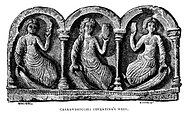
Back Keltische Religion ALS وثنية قلطية Arabic Politeísmu celta AST Köitische Getta BAR Politeisme celta Catalan Keltské náboženství Czech Crefydd Geltaidd Welsh Keltisk religion Danish Keltische Religion German Politeísmo celta Spanish
| Part of a series on |
| Celtic mythologies |
|---|
 |

Ancient Celtic religion, commonly known as Celtic paganism,[1][2][3] was the religion of the ancient Celtic peoples of Europe. Because there are no extant native records of their beliefs, evidence about their religion is gleaned from archaeology, Greco-Roman accounts (some of them hostile and probably not well-informed), and literature from the early Christian period.[4] Celtic paganism was one of a larger group of polytheistic Indo-European religions of Iron Age Europe.
While the specific deities worshipped varied by region and over time, underlying this were broad similarities[5] in both deities[6] and "a basic religious homogeneity" among the Celtic peoples.[7] Widely worshipped Celtic gods include: Lugus, Toutatis, Taranis, Cernunnos, Epona, Maponos, Belenos, Ogmios, and Sucellos.[6][4] Sacred springs were often associated with Celtic healing deities.[8] Triplicity is a common theme, with a number of deities seen as threefold, for example the Three Mothers.
The druids were the priests of Celtic religion, but little is definitively known about them.[9] Greco-Roman writers said the Celts held ceremonies in sacred groves and other natural shrines, called nemetons, while some Celtic peoples also built temples or ritual enclosures.[6] Celtic peoples often made votive offerings which would be deposited in water and wetlands, or in ritual shafts and wells.[6] There is evidence that ancient Celtic peoples sacrificed animals, almost always livestock or working animals.[10] There is also some evidence that ancient Celts sacrificed humans and, though possibly imperial propaganda, some Greco-Roman sources claim the Gauls sacrificed criminals by burning them in a wicker man.[11]
- ^ Ross 1974[page needed]
- ^ Hutton 1991[page needed]
- ^ Jones, Prudence and Pennick, Nigel (1995). A History of Pagan Europe. Routledge.
- ^ a b Green, Miranda (2012). "Chapter 25: The Gods and the supernatural", The Celtic World. Routledge. pp.465–485
- ^ Cunliffe 1997, p. 184
- ^ a b c d Cunliffe 1997, pp. 275–277, 286, 291–296
- ^ Ross 1986, p. 103
- ^ Koch 2006, pp. 1488–1491
- ^ Hutton 2009, p. 17
- ^ Cite error: The named reference
Green94-96was invoked but never defined (see the help page). - ^ Cite error: The named reference
koch687-690was invoked but never defined (see the help page).
© MMXXIII Rich X Search. We shall prevail. All rights reserved. Rich X Search